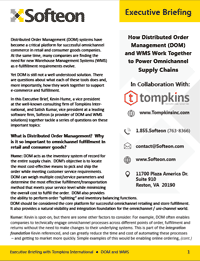 |
June 16, 2017 - Supply Chain Flagship Newsletter |
 |
| FEATURED REPORT |
|||
|
New Report Supply Chain Executive Brief: How Distributed Order Management (DOM)
Satish Kumar from Softeon and Kevin Hume from Tompkins International
|
|||
 |
|
||||||||||||||||||||||||||||||||||||||||||||||||||||||||||||||||||||||||||||||||||||||||||||||||||||
|
|||||||||||||||||||||||||||||||||||||||||||||||||||||||||||||||||||||||||||||||||||||||||||||||||||||
|
|||||||||||||||||||||||||||||||||||||||||||||||||||||||||||||||||||||||||||||||||||||||||||||||||||||
|
|||||||||||||||||||||||||||||||||||||||||||||||||||||||||||||||||||||||||||||||||||||||||||||||||||||
|
|
|
YOUR FEEDBACKS
Some of the many emails we received on SCDigest Editor Dan Gilmore's column on Irrational Shipping Prices and the Demise of Brick and Mortar Retail and Reader Respond - Irrational Shipping Prices and the Demise of Brick and Mortar Retail.
More soon.
Feedback on Irrational Shipping Prices and the Demise of Brick and Mortar Retail Parts 1 and 2
![]()
Great article by Dan Gilmore, I think he's spot on with his commentary. The state of brick & mortar retailers is hard to watch from a consumer's standpoint versus and investor standpoint. When it comes to apparel, for the most part I personally I have to feel it, touch it, and try it on. Certain on-line purchases make sense and are extremely convenient. I guess it comes down to comfort level and how tech savvy the consumer tends to be with technology.
It will interesting to see how things play out with Amazon and their quest to dominate the world's global supply chain. When does it stop or does it ever stop? Will the success/failure continue to be investor driven, consumer driven or both?
I look forward to reading Dan's future columns and appreciate the opportunity to provide feedback. Wishing SC Digest much continued success in 2017 and beyond.
John L. Antonucci
VP Corporate Accounts
721 Logistics LLC
![]()
While I see the truth in what you are saying generally, I think you are being a bit too broad. Retail is surely suffering in some places, and some malls are having tough times. But I think it is tied more to the geo and the forward thinking of retailers. Most should have joined the on-line bandwagon sooner rather than worrying about B&M operations losing out. Most should have figured out how to incorporate the stores (kiosks, store pickup, etc.). I love that I can order from Walmart (and others) online and pick my order up at the store 1 mile away in 2 hours or less. Most should have figured out the Gen X and Millennials a long time ago.
On the subject of malls and geo. Consumers like the trick, new thing. Upgrade your mall (and your thinking) and you may find a real winner.
I live in the Salt Lake City area - a pretty tech savvy place (Ogden, Salt Lake, Provo). Recently the LDS church opened a new downtown (City Creek) mall to rave reviews and lots of business. There is a suburban mall (Fashion Place) which is almost too busy to visit with a soon to open, very large Macy's plus Nordstrom, Dillard's (replaced Sears), Crate & Barrel and many other high end stores. Fashion Place has been around for 50 years and has recently been revitalized to focus on a more selective (high income, young) market.
Another recent success is the Valley Fair Mall - which has been revitalized. Another downtown mall that was extremely popular until City Creek opened was the Gateway. Gateway (an open outdoor type mall) is going through modernization (although it is less than 20 years old) to better compete with City Creek.
A common feature of the successful locations seems to be the Apple Store. Hip, young (or young at heart) shoppers seem to enjoy good shopping, good food and features that appeal to them. Apple was at Gateway until City Creek opened.
Older malls and retail need to take notice.
Steven R. Murray
Supply Chain Visions
Editor's Note:
I think you are missing a few critical few points:
What would happen to ecommerce sales if appropriate pick pack and ship costs were charged?
Items in store should actually be priced lower than online products, because the costs are way lower - but they are not.
Because these things, brick and mortar woes, and the unbelievable change ecommerce is bringing, is happening much faster than it should.
Someday, these costs will have o be charged. They simply must be.
Dan Gilmore

![]()
Great article, really interesting perspective on how Amazon may be accelerating the penetration of ecommerce.
I would contest one statement you make about the price of typical goods, and that in most cases they should be priced cheaper than ecommerce. I understand the point you are making, that shipping costs are built into the in-store price but are not being built into the ecommerce prices yet; however, there are other brick and mortar costs (facilities, rent, equipment, labour, etc) that need to be built into an in-store price - many of these represent costs that ecommerce avoid completely. To me, these costs are material, and comprise the basic essence of why ecommerce is winning.
Mark Johnston
![]()
I do agree with Gilmore!
On this track, I read not so long ago that about 90% of new business strategies fail. Further, that it is typical to find that there's something that will work arising out of the failure, thus it is wise to maintain resources in reserve to apply in support of that successful element going forward. There are many stories of massive all-in, bet-the-farm commercial disasters. The other salient observation offered was that long term success was more often achieved by strategies that started small and achieved profitability early and then leveraged to gain share vs. those that stressed rapidly building market share at a loss from the start while striving to cross some far off break-even tipping point.
By appearances, Amazon's journey seems like it falls prey to the considerations above. Maybe they made some money early on when they only sold books. Since then, my sense is that it's been 2% or less profit or losses, and should revenue growth sputter- look out?
Meanwhile Mass Merchants and other retail leaders are dealing with the disruption, and from what I can tell, are mighty worried and not just a little grumpy about dealing with all the challenges associated with Omni channel.
Meanwhile, the ‘music continues to play'.
Tom Miralia
Distribution Technology

SUPPLY CHAIN TRIVIA ANSWER
Q: The first computerized supply chain network optimization tool is generally believed to have created in what year?
A: 1972, by Dr. Arthur Geoffrion and Dr. Glenn Graves of UCLA, we believe for Del Monte’s supply chain.
| © SupplyChainDigest™ 2003-2017. All Rights Reserved. SupplyChainDigest PO Box 714 Springboro, Ohio 45066 |
POWERED BY: XDIMENSION
|







